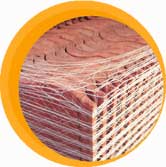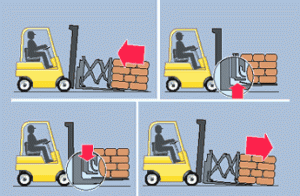1) What is a slip sheet?
The slip sheet is used as a portable material handling base for storage and transportation of unitized goods. It is actually a thin sheet ( from 0.5mm to 2.5mm) made from solid fibre , corrugated board or plastic materials.
2) Background
After World War II , the wooden pallet has become the primary portable platform/base for the movement and storage of goods in the advent of containerization.
However , shippers are always looking for innovative ways to reduce cost and receivers are searching for ways to reduce trash disposal costs.The large US food processors were the first industry group to adopt slip sheets during the 1970’s .The slip sheet was developed by such companies as General Foods and Quaker Oats for shipment of their goods.
The first slip sheets were made from solid fibre and later corrugated kraft liner medium . A little later the plastic slip sheet made its appearance.
The “green” movement to reduce usage of wood and the implementation of the ISPM15 (Regulation of Wood Pacakaging Material in International Trade) has led to exporters shifting to other portable bases such as slip sheets, paper pallets, pressed wood pallets and plastic pallets.
3) Construction of the plastic slip sheet
This can be made from any kind of combination of polmerized material , including but not limited to polyethylene or polypropylene that provide adequate tensile strength . Most of the plastic material used are recycled. The most common method of production is by extrusion.
4) Specifications
4.1 Tensile Strength
This is the strength per unit cross-sectional area.It will determine how thick a slip sheet need to be in order to support a given payload. For practical purposes, it is given as thickness versus load capacity . For example , a typical PE slip sheet will have the following load capacities versus thickness:
Thickness (mm) Load Capacity (tonne)
0.7 1.0
0.9 1.2
1.1 1.5
1.6 2.0
2.2 3.0
4.2 Coefficient Of Friction
The side of the slip sheet where the goods sit on must have high slip resistance so that the goods will not slide off during loading, unloading or movement.However, the reverse side has to be smooth so that the loaded slip sheet can slide on the floor /pallet smoothly during loading and unloading . The standard measure of slip resistance is known as the coefficient of friction where the higher value signifies a higher slip resistance.
In practice ,one side of the slip sheet is embossed with a criss-cross pattern to increase the friction while the opposite side is smooth. Typical coefficient of riction values for plastic slip sheets are :
Side Coefficient of friction
Embossed face(rough) 0.5+
Smooth face 0.2 – 0.3
5.0) Pull Tabs
Pull tabs are areas at the edges of the slip sheet where the gripper clamps on during loading and unloading . More tabs will allow the handling equipment to approach the loaded slip sheet from more sides (very much like the 1-way,2-way 4-way entry pallet concept).
5.1 No. of tabs
There are 4 possible configuration :
i) Single tab
ii) Two opposite tabs
iii) Two adjacent tabs
iv) Four tabs
The typical tab width can range from 75 – 100mm .Unlike the solid fibre slip sheet, the tabs are not clearly defined as no scoring or cutting are necessary to form the tabs for the plastic slip sheet.
5.2 Scoring
Scoring is only necessary for solid fibre and corrugated slip sheets. As the solid fibre is stiff, scoring and cutting at the corners are necessary to allow the tab to bend upto 90 degrees. Otherwise , the stiff fibre will crack and the tab will tear when the gripper clamps on it and pull on it .
As the plastic slip sheet is very flexible , scoring or cutting at the corners to from the tabs are not necessary. A typical plastic slip sheet therefore appears as a rectangular sheet with no clear demarcation of the tabs. The user has the flexibility to assign the pull tab(s) during use when loading the goods onto it.
6.0 Unitizing
The common feature of using pallet and slip sheet is that the goods need to be unitized.
Individual products are combined and shipped in larger unitized loads . These unitized loads can then be handled using mechanical handling equipment saving cost of manual labour and turn-around time . There is also less pilferage and less handling damage so less costly protective packaging is needed. The load is unitized using the following methods or combination of methods :
i) Strapping
The goods are strapped together to form a single load.
ii) Shrink wrapping
The plastic shrink film /bag is put over the goods and heat shrinked to form a unitized load.
iii) Stretch Wrapping
The stretch film is wrapped around the goods to form a unitized load.This can be done manually or by using a machine.
iv) Net Wrapping
The goods are wrapped with netting or perforated film . Normally , done for goods that need to “breathe ” like fruits and vegetables.
v) Using adhesives
Each layer of products are glued onto the next so that they form a unitized load .
vi) Using hot-melts
This is similar to using adhesive except that hot-melt adhesives are used.
viii) Rubber banding
Big rubber bands are used to tie the products together to form a unitized load.
7.0) Handling the Slip Sheets
It should be noted that the slip sheet handling equipment must be available at both the shipping and receiving stations for loading and unloading the goods shipped on slip sheets.
7.1 Push-and- Pull Attachment
This is an attachment for the forklift so that it can handle the loaded slip sheet . It basically has a gripper which grips the pull tab and pull the loaded slip sheet onto its 2 platform arms for transportation. In unloading, it pushes the loaded slip sheet onto the pallet or floor.The attachment just fits onto the normal forklift (without need to remove the original forks) and it takes only a few minutes.
7.2 Rollerforks
This is also an attachment for the forklift . It has 2 sets of rollers on each arm which can roll the loaded slip sheet onto the arms for transportation. A specially designed pallet with extra slats(RF pallet) will greatly improve efficiency of handling the slip sheets when used with the rollerforks . The rollerforks can also be used with the normal pallets.
8.0) Using the slip sheets
8.1 Inside the factory or warehouse, the slip sheet is placed on top of the pallet and the goods are loaded on top of it. The slip sheet is arranged on the pallet so that the desired pull tab(s) extend out from the edge(s) of the pallet . With this arrangement , the push pull attachment can easily grip the tab later on.
8.2 The goods are normally moved about within the premises using these captive pallets ( these pallets never leave the premises). Some organizations invest in high quality plastic captive pallets .All movement of the goods within the premises is done using the forklift and pallet just like normal.However, this movement can also be done using the slip sheet if so desired.
8.3 The goods on the pallet are unitized ,either before storage or just before loading into tthe container/truck for shipment.
8.4 When loading the loaded slip sheet into the container or truck, the push pull or rollerforks attachment will be needed.
8.5 It is possible to retrieve and save the slip sheet when loading the goods into the container or truck using a specially designed push pull attachment.In which case, the goods will have to be unloaded manually at the discharge destination.
9.0) References
9.5 ISO 12776:2008, Pallets-Slip sheets

















